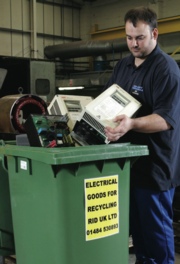The controlled approach to reduce energy and carbon

Renewables offer an obvious way to tackle carbon reduction targets for the built environment, but other less visible technologies can achieve excellent carbon and energy savings — and often in a more cost-effective way.
The drive for greater use of building-integrated renewables has been underway for some time. In the UK we have seen increased take-up of technologies such as air- and ground-source heat pumps, combined heat and power and solar thermal systems.
While all these technologies certainly reduce the carbon footprint of commercial buildings, one of the main hurdles to their adoption can be the cost. Furthermore, retrofitting these technologies to an existing commercial building is not always straightforward.
Ian Ellis, president of the Building Controls Industry Association, says: ‘Renewable technologies have received a lot of backing through legislation and grants. The BCIA certainly supports their use where appropriate, but we feel that controls technology can offer outstanding energy and carbon savings. Building controls also work regardless of the energy generation method. They can be used on new and existing buildings at a reasonable cost, and with a potentially quick payback.’
One of the reasons that controls can be overlooked is that they are ‘hidden’ energy savers. As they are often tucked away in plant rooms or within other equipment, controls don’t seem an obvious solution to the challenge of energy reduction. This can be particularly true of technologies such as variable-speed drives, actuators and dampers.
Pete Winterbottom, UK manager for HVAC drives at ABB says, ‘Fans, pumps, air handling units and chilled water pumps are all driven by motors — and they are big users of energy. Reducing the energy used by these motors is a very quick win in terms of energy costs and carbon. Specifically, when the motor speed is reduced by 20%, you save around 50% on the energy consumption of the plant.’
Winterbottom says that by using electronic variable-speed drives (VSDs, also known as frequency converters), the energy used by equipment such as fans and pumps can be reduced dramatically. ‘Variable speed drives work by graduating the speed of a motor. As you move down the speed curve, the power required reduces as the cube of the speed. This means that energy savings mount up very quickly,’ he explains.
VSDs can be controlled through the building management system (BMS) or they can be controlled directly, as the latest models include their own PID loops and time clocks. ‘If your plant is oversized, as is often the case, you can install this equipment and save money within weeks. You also reduce mechanical wear-and-tear on the plant because the VSD provides soft start control too,’ adds Winterbottom.
Andy Bartlett, managing director of Belimo agrees that this type of control can give excellent energy and carbon-saving results. ‘One of the key points about using building controls is that they match the performance of building-services equipment to actual demand. For example, in a VAV air-conditioning system, if you can control fan output selectively to match demand, you can reduce energy consumption by as much as 50%. This means rapid payback on investment, even in small and medium buildings.’

Not only can users save money on their energy use, occupant comfort is also increased. ‘Controlling fan output means reduced noise and better control for occupants,’ adds Bartlett.
A European Standard EN 15232 ‘Setting standards for automation and control in buildings’ was developed in support of the European Energy Performance of Buildings Directive. Research for this standard shows impressive energy savings resulting from the application of controls technologies. It outlines savings in both thermal energy and electrical energy. For example, building controls in office buildings can save 30% of thermal energy and 13% of electricity; for shopping centres the figures are 40% and 9%, respectively.
Steve Reid, solutions development engineer at Siemens Building Technologies says, ‘We have carried out a number of projects across Europe that show these figures to be correct. At the Algemeen Stedelijk Zeikenuis Alast hospital in Belgium, Siemens controls engineers adjusted setpoints and schedule programs in the building-management system. They also installed an optimised start/stop program and improved the control strategy for cooling generation and distribution.’
As a result of improving the level of building control in the hospital, there was a 35.7% reduction in energy used for heating, and electricity consumption was cut by 15.8%. The overall effect was a 22% reduction in CO2 emissions from the building. Perhaps most impressively, the payback period for this project was six months.









